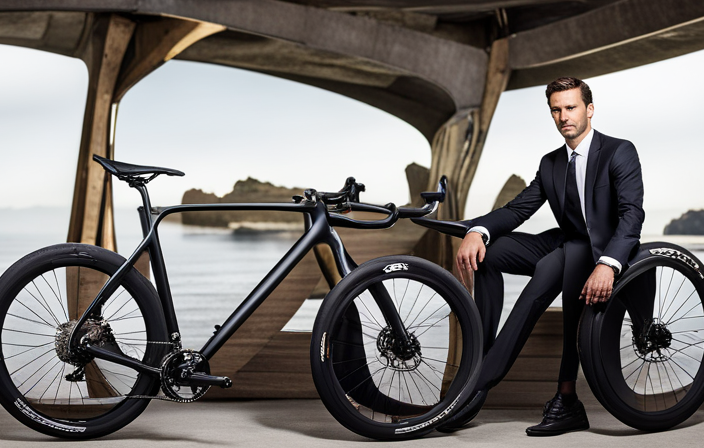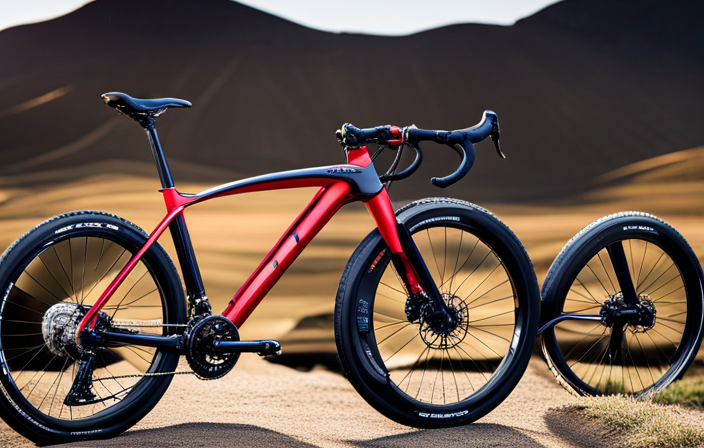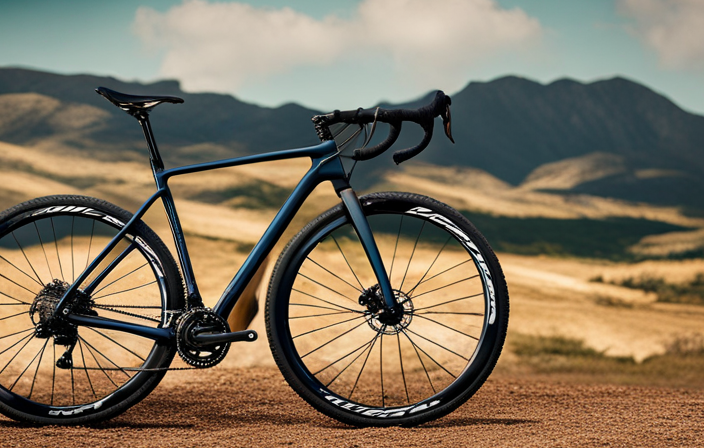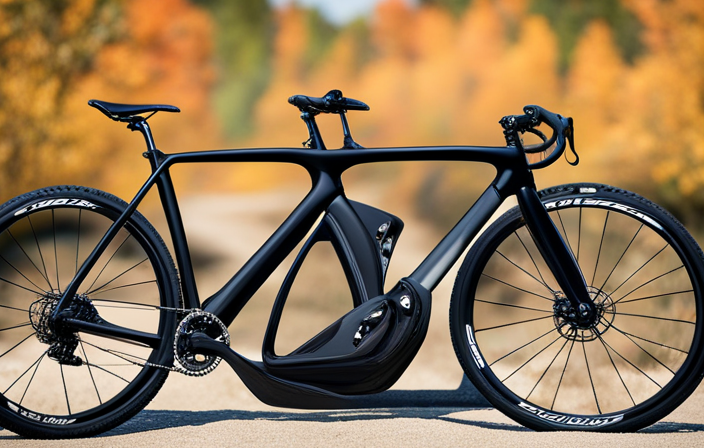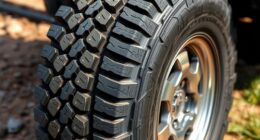Are you prepared to go on exciting gravel bike journeys in San Diego?
Picture this: the wind rushing through your hair as you conquer the challenging trails of Black Mountain Open Space Park.
Feel the adrenaline pumping through your veins as you navigate the rugged terrain of Los Penasquitos Canyon Preserve.
Get lost in the awe-inspiring beauty of Mission Trails Regional Park.
Join me on a journey to discover the best gravel bike routes in San Diego, where every pedal stroke will leave you craving for more.
Key Takeaways
- San Diego offers a variety of well-maintained gravel bike trails with diverse terrain and landscapes.
- Gravel bikers in San Diego can enjoy scenic views of mountains, canyons, and lakes.
- Riders can expect abundant wildlife sightings while exploring the gravel bike trails in San Diego.
- The gravel bike trails in San Diego are suitable for both beginners and experienced riders.
Black Mountain Open Space Park
You can ride your gravel bike at Black Mountain Open Space Park in San Diego, and it’s an incredible experience. The park offers a variety of black mountain trails that are perfect for gravel biking enthusiasts like myself. The trails are well-maintained, with just the right amount of challenge to keep you engaged and excited.
One of the great things about riding at Black Mountain Open Space Park is that there is no bad time to go. Whether you prefer early morning rides or late afternoon adventures, this park has got you covered. I personally love going in the early morning when the air is crisp and the sun is just starting to rise. It’s a magical feeling being out on the trail with only the sound of nature surrounding you.
Now, let’s transition into our next destination: Los Penasquitos Canyon Preserve. This beautiful preserve offers even more opportunities for gravel biking in San Diego. So hop back on your bike and get ready for another amazing adventure through breathtaking landscapes and challenging terrain.
Los Penasquitos Canyon Preserve
Explore the stunning Los Penasquitos Canyon Preserve on your next gravel biking adventure. This hidden gem offers some of the best mountain biking trails in San Diego, with a variety of options to suit riders of all skill levels. The preserve features over 37 miles of trails that wind through diverse landscapes, including oak woodlands, riparian forests, and rolling grasslands.
One of the highlights of Los Penasquitos Canyon Preserve is its well-maintained trail system. The paths are wide and well-marked, making it easy to navigate through the park. The trail conditions are generally excellent, with minimal erosion and obstacles along the way. You can expect a smooth ride as you pedal your way through the preserve.
The mountain biking experience at Los Penasquitos Canyon Preserve is truly unparalleled. Whether you’re a beginner looking for a leisurely ride or an experienced rider seeking a challenge, there’s something for everyone here. From gentle slopes to steep descents, you’ll find trails that cater to your preferences.
As you wrap up your exhilarating ride at Los Penasquitos Canyon Preserve, get ready to continue your gravel biking journey at Mission Trails Regional Park.
Mission Trails Regional Park
Located just a short distance from Los Penasquitos Canyon Preserve, Mission Trails Regional Park offers a variety of trails for outdoor enthusiasts to enjoy. As someone who loves riding my gravel bike in San Diego, I can’t get enough of the amazing gravel bike trails in this beautiful park.
Here are four reasons why Mission Trails Regional Park is a must-visit destination for gravel biking:
-
Diverse Terrain: From rolling hills to challenging climbs, the park has something for every skill level. You’ll never get bored exploring the different trails and experiencing the thrill of navigating through varied landscapes.
-
Scenic Views: As you ride through Mission Trails Regional Park, you’ll be surrounded by stunning natural beauty. Enjoy picturesque vistas of mountains, canyons, and lakes as you pedal along the well-maintained paths.
-
Abundant Wildlife: Keep your eyes peeled for wildlife sightings during your ride! The park is home to numerous species of birds, rabbits, squirrels, and even coyotes. It’s always exciting to spot these creatures in their natural habitat.
-
Trail Variety: Whether you prefer smooth gravel paths or more technical singletrack sections, there’s a trail for everyone here. Explore at your own pace and discover new routes each time you visit.
Now let’s transition into our next destination – Lake Hodges – where more thrilling gravel bike adventures await!
Lake Hodges
Lake Hodges offers a new and exciting destination for gravel biking enthusiasts in the San Diego area. With its diverse terrain and stunning views, it is the perfect place to explore on two wheels. There are several gravel bike routes that wind their way through this scenic landscape, providing riders with a thrilling adventure.
One of the most popular trails at Lake Hodges is the Coast to Crest Trail. This route takes you along the shoreline of the lake, offering breathtaking views of the water and surrounding hills. The trail is well-maintained and features a mix of hard-packed dirt and gravel, making it ideal for gravel biking.
Another great option is the Del Dios Gorge Trail, which takes riders through a beautiful canyon with towering cliffs on either side. The trail offers challenging climbs and descents, as well as sweeping views of Lake Hodges below.
For those looking for a longer ride, there are also several loop options available at Lake Hodges. These loops range in difficulty from beginner-friendly to more advanced, ensuring that there is something for everyone.
In conclusion, Lake Hodges provides gravel biking enthusiasts with an abundance of scenic trails to explore. With its diverse terrain and breathtaking views, it is a must-visit destination for any cyclist in the San Diego area.
Now let’s transition into our next stop: Daley Ranch!
Daley Ranch
To fully experience Daley Ranch, you can immerse yourself in the stunning natural beauty of this expansive park with its diverse trails and captivating wildlife. As a gravel bike enthusiast, I can confidently say that Daley Ranch offers some of the best biking routes in San Diego.
The park boasts over 20 miles of well-maintained gravel bike trails that cater to riders of all skill levels. One popular route is the Boulder Loop Trail, which takes you through rolling hills and provides breathtaking views of the surrounding countryside. For a more challenging ride, the Ranch House Loop offers steep climbs and technical descents that will put your skills to the test. If you’re up for an epic adventure, try combining multiple trails for a longer ride that will truly push your limits.
While exploring these incredible trails, keep an eye out for the abundant wildlife that calls Daley Ranch home. From deer grazing peacefully in meadows to colorful birds soaring overhead, every turn offers a new opportunity to connect with nature.
As we transition into our next destination, Otay Valley Regional Park, get ready to discover even more exciting gravel bike trails just waiting to be explored.
Otay Valley Regional Park
Get ready to explore even more exciting trails at Otay Valley Regional Park. Here, you can immerse yourself in the natural beauty and diverse wildlife of this stunning park. Located in San Diego, Otay Valley Regional Park offers a fantastic gravel bike riding experience for outdoor enthusiasts of all levels.
As you venture through the park’s extensive trail network, you’ll be treated to breathtaking views of rolling hills, vibrant wildflowers, and tranquil ponds. The park is home to various habitats, including wetlands and riparian areas, providing a haven for numerous bird species such as egrets, herons, and hawks. Keep your eyes peeled for coyotes, rabbits, and other wildlife that call this place their home.
The gravel roads at Otay Valley Regional Park are well-maintained and offer a mix of smooth sections and challenging climbs. Whether you’re seeking an adrenaline-pumping ride or a leisurely pedal surrounded by nature’s serenity, this park has it all.
Now let’s transition into our next destination: the San Dieguito River Park.
San Dieguito River Park
After exploring the beautiful trails at Otay Valley Regional Park, I was eager to continue my gravel bike adventure in San Diego. That’s when I discovered the hidden gem known as San Dieguito River Park.
This off-road cycling paradise offers a variety of nature trails that are perfect for outdoor enthusiasts like me. San Dieguito River Park is a haven for those seeking an adrenaline-pumping outdoor adventure. With its vast network of trails, there is something for everyone, from beginners to seasoned riders.
The park boasts miles of well-maintained paths that wind through scenic landscapes, providing breathtaking views of the surrounding nature. As I pedaled my way through the park, I couldn’t help but be amazed by the diverse flora and fauna that surrounded me. The lush greenery and tranquil river create a serene atmosphere that is truly unmatched.
Whether you’re looking to challenge yourself on technical terrain or simply enjoy a leisurely ride immersed in nature, San Dieguito River Park has it all. With its combination of stunning scenery and thrilling trails, this park is a must-visit destination for any gravel bike enthusiast visiting San Diego. So gear up and get ready to embark on an unforgettable cycling journey through the wonders of San Dieguito River Park.
Now let’s transition seamlessly into our next destination: Elfin Forest Recreational Reserve…
Elfin Forest Recreational Reserve
Explore the enchanting trails of Elfin Forest Recreational Reserve and immerse yourself in its captivating natural beauty. The reserve is a hidden gem located just north of San Diego, offering a paradise for outdoor enthusiasts. Whether you prefer hiking or mountain biking, Elfin Forest has something for everyone.
The elfin forest hiking trails wind through dense woodlands, providing a peaceful escape from the hustle and bustle of city life. As you traverse the paths, you’ll be surrounded by towering oak trees and lush vegetation. The air is filled with the sweet scent of wildflowers, creating a sensory experience like no other.
For those seeking more adrenaline-pumping adventures, the elfin forest mountain biking trails are perfect for you. With varying levels of difficulty, riders can test their skills and push their limits on the rugged terrain. From thrilling downhill descents to challenging uphill climbs, every turn offers an exciting new challenge.
Transitioning into Santa Ysabel Open Space Preserve without missing a beat, venture further east to discover another stunning destination for gravel bike enthusiasts.
Santa Ysabel Open Space Preserve
Located just east of Elfin Forest Recreational Reserve, Santa Ysabel Open Space Preserve offers yet another breathtaking destination for outdoor enthusiasts. This hidden gem in San Diego County is a paradise for gravel biking, with its diverse terrain and stunning natural beauty.
Here are some of the best routes for gravel biking at Santa Ysabel Open Space Preserve:
-
Oak Loop Trail: This scenic trail takes you through a dense oak woodland, offering shade and tranquility as you pedal along. The trail is well-maintained and provides a mix of rolling hills and flat sections, making it suitable for riders of all skill levels.
-
Meadows Trail: As the name suggests, this route takes you through picturesque meadows filled with vibrant wildflowers during springtime. The smooth gravel path makes for a pleasant ride as you admire the panoramic views of the surrounding mountains.
-
Creek Crossings Trail: For those seeking more adventure, this trail includes several creek crossings that add an element of excitement to your ride. You’ll navigate through rocky sections and enjoy the peaceful sounds of running water as you explore this rugged terrain.
-
Summit View Trail: As the highlight of Santa Ysabel Open Space Preserve, this trail rewards riders with breathtaking panoramic views at its highest point. Be prepared for a challenging climb before reaching the summit, but rest assured that the view will be well worth your effort.
Continuing our journey from Santa Ysabel Open Space Preserve to Cuyamaca Rancho State Park…
Cuyamaca Rancho State Park
Nestled in the mountains of eastern San Diego County, Cuyamaca Rancho State Park offers a wide range of outdoor activities for nature lovers. With its expansive mountain biking trails and diverse landscape, this park provides endless opportunities for outdoor recreation.
One of the main highlights of Cuyamaca Rancho State Park is its extensive network of mountain biking trails. From beginner-friendly paths to more challenging routes, there is something for riders of all skill levels. As you navigate through the park’s winding trails, you’ll be treated to breathtaking views of lush meadows, dense forests, and sparkling lakes. The adrenaline rush as you conquer each twist and turn is unmatched.
In addition to mountain biking, Cuyamaca Rancho State Park also offers a plethora of other outdoor recreation opportunities. Hiking enthusiasts can explore the park’s numerous scenic trails that lead to hidden waterfalls and panoramic viewpoints. Birdwatchers will be delighted by the abundance of bird species that call this park home.
As your adventure comes to an end in Cuyamaca Rancho State Park, get ready to continue your exploration at the nearby Mount Laguna Recreation Area. This stunning destination offers even more opportunities for outdoor fun and excitement.
Mount Laguna Recreation Area
The Mount Laguna Recreation Area is a picturesque destination in eastern San Diego County that offers a variety of outdoor activities for nature enthusiasts. Nestled amidst the Cleveland National Forest, this stunning area boasts breathtaking scenic views and endless opportunities for adventure. Whether you’re an avid hiker, mountain biker, or camper, Mount Laguna has something for everyone.
Here are five reasons why you should visit the Mount Laguna Recreation Area:
-
Mount Laguna Camping: Immerse yourself in nature by spending a night under the stars at one of the campgrounds in the area. Wake up to crisp mountain air and enjoy the tranquility of your surroundings.
-
Scenic Views: From panoramic vistas to lush meadows, every corner of Mount Laguna offers awe-inspiring views that will leave you speechless. Capture Instagram-worthy photos and create memories that will last a lifetime.
-
Hiking Trails: Lace up your hiking boots and explore the numerous trails that wind through this beautiful landscape. Choose from easy strolls to more challenging treks, all while immersing yourself in nature’s beauty.
-
Mountain Biking: Get your adrenaline pumping as you navigate the thrilling mountain bike trails at Mount Laguna. Feel the rush as you cruise through rugged terrain and take in breathtaking views along the way.
-
Wildlife Watching: Keep an eye out for native wildlife such as deer, foxes, and birds as you traverse through this natural wonderland. Spotting these creatures in their natural habitat is a truly magical experience.
As we transition into exploring the ‘noble canyon trail,’ get ready for another exhilarating adventure filled with epic landscapes and thrilling descents!
Noble Canyon Trail
Get ready to embark on an exciting journey along the Noble Canyon Trail, known for its epic landscapes and exhilarating descents! Mountain biking in Noble Canyon offers some of the best trails in the area, attracting riders of all skill levels. With its rugged terrain and breathtaking views, this trail is a must-ride for gravel bike enthusiasts visiting San Diego.
To give you a taste of what to expect on this thrilling adventure, check out the table below that highlights five key features of the Noble Canyon Trail:
| Feature | Description |
|---|---|
| Technicality | Challenging singletrack with rocky sections and technical drops |
| Scenery | Stunning vistas of rugged canyons and lush forests |
| Elevation Gain | A mix of climbs and descents with a total elevation gain of 2,000ft |
| Trail Condition | Well-maintained trail surface ideal for gravel bikes |
| Difficulty | Intermediate to advanced |
As you navigate through the twists and turns of this legendary trail, be prepared for an adrenaline rush like no other. The combination of technicality, stunning scenery, and challenging climbs will leave you breathless.
Now that we’ve conquered Noble Canyon Trail’s exhilarating challenges, it’s time to continue our exploration at another iconic location: San Juan Trail.
San Juan Trail
Once you arrive at the trailhead, you’ll be greeted by the enchanting San Juan Trail. This hidden gem is one of the best gravel bike trails in San Diego, offering an exhilarating and scenic ride for all skill levels. As you embark on this adventure, get ready to be captivated by breathtaking views of rolling hills, lush greenery, and picturesque landscapes.
The San Juan Trail spans approximately 11 miles and provides a thrilling mix of challenging climbs and fast descents. The terrain is a combination of hard-packed dirt, loose rocks, and occasional technical sections that will put your skills to the test. But don’t worry – it’s nothing a well-equipped gravel bike can’t handle!
What sets the San Juan Trail apart from other trails in the area is its tranquility and solitude. You’ll find yourself immersed in nature’s beauty as you pedal through dense forests and along meandering creeks. It truly is a peaceful escape from the hustle and bustle of city life.
After conquering the San Juan Trail, it’s time to continue your gravel bike journey towards the next thrilling destination: Corral Canyon OHV Area. Get ready for more heart-pumping adventures as we explore this off-road paradise just a short distance away.
(Note: Transition into subsequent section about ‘Corral Canyon OHV Area’ without writing ‘step’.)
Corral Canyon OHV Area
When you arrive at the Corral Canyon OHV Area, you’ll be amazed by the thrilling off-road opportunities that await. The Corral Canyon OHV Area is one of the best routes for gravel biking in San Diego, offering an exhilarating experience for riders of all skill levels.
Here are some reasons why this area should be at the top of your list:
-
Diverse Terrain: From steep climbs to fast descents and everything in between, the Corral Canyon OHV Area has it all. You’ll encounter rocky trails, sandy washes, and even some technical sections that will put your skills to the test.
-
Scenic Views: As you pedal through this beautiful area, you’ll be treated to breathtaking views of the surrounding mountains and canyons. It’s a picturesque setting that adds to the overall enjoyment of your ride.
-
Trail Variety: With a network of interconnected trails, there’s no shortage of options at Corral Canyon OHV Area. Whether you’re looking for a short and scenic ride or a longer adventure, you’ll find something to suit your preferences.
-
Wildlife Encounters: Keep an eye out for local wildlife as you explore this area. From deer and rabbits to birds of prey soaring above, there’s always something interesting to see along the way.
As you wrap up your ride at Corral Canyon OHV Area, get ready for another exciting section about ‘Old Julian Highway.’
Old Julian Highway
As I continue my journey through the Corral Canyon OHV Area, I’m excited to explore the historic and scenic Old Julian Highway. This gravel road stretches for approximately 16 miles, providing a challenging and rewarding ride for gravel bike enthusiasts like myself.
The Old Julian Highway is rich in history, dating back to the late 1800s when it was used as a stagecoach route. Today, it offers riders stunning views of rolling hills, oak trees, and picturesque landscapes that make you feel like you’ve stepped back in time.
When it comes to the best time to ride the Old Julian Highway, I highly recommend going during the spring or fall seasons. The weather is mild during these times, making for comfortable riding conditions. Plus, the surrounding nature comes alive with vibrant colors and blooming wildflowers.
Be prepared for some steep climbs and descents along this route, as well as sections with loose gravel. But don’t let that deter you! The challenging terrain only adds to the sense of adventure and accomplishment when conquering this historic highway.
So gear up, hop on your gravel bike, and get ready to experience the beauty and history of the Old Julian Highway. It’s a ride you won’t soon forget!
Frequently Asked Questions
Are there any restrictions or permits required to ride at the Corral Canyon OHV Area?
No, there are no permits or restrictions required to ride at the Corral Canyon OHV Area.
It’s a fantastic spot for gravel biking enthusiasts like myself to explore and enjoy the rugged beauty of San Diego.
With its diverse terrain and breathtaking views, you can tackle challenging trails while soaking in the natural surroundings.
So grab your bike, gear up, and get ready for an exhilarating adventure without any bureaucratic hassles!
What is the difficulty level of the trails at Daley Ranch?
They say, ‘No pain, no gain.’ And that couldn’t be truer when it comes to the trails at Daley Ranch.
The difficulty level of these gravel bike trails in San Diego is not for the faint of heart. With steep climbs, technical descents, and challenging terrain, it’s a true test of endurance and skill.
But for those who dare to take on the challenge, the reward is an exhilarating ride through breathtaking scenery and a sense of accomplishment like no other.
Can I bring my dog to ride at the San Dieguito River Park?
Yes, you can bring your dog to ride at the San Dieguito River Park! The park offers dog-friendly trails where you and your furry friend can enjoy a great ride together.
Not only will you have a fantastic time exploring the beautiful scenery, but there are also alternative routes available for those seeking a bit more adventure.
So grab your bike, leash up your pup, and get ready for an unforgettable experience in the San Dieguito River Park!
Are there any beginner-friendly trails at Mount Laguna Recreation Area?
Beginner-friendly gravel routes at Mount Laguna Recreation Area? Absolutely! You’ll be blown away by the stunning beauty and exhilarating trails that await you here.
To make the most of your ride, I recommend starting with the Noble Canyon Trail. It offers a mix of smooth paths and gentle climbs, perfect for beginners.
Remember to bring plenty of water, snacks, and a map. Stay safe and have an unforgettable adventure exploring this incredible area!
Is there parking available at the start of the Old Julian Highway trail?
Yes, there is parking available at the start of the Old Julian Highway trail. The parking lot is conveniently located near the trailhead, making it easy to access.
As for the trail conditions, they are generally well-maintained and suitable for gravel biking. However, it’s always a good idea to check with local authorities or online resources for any recent updates on trail conditions before heading out.
Happy riding!
Conclusion
In conclusion, San Diego is a hidden gem for gravel bike enthusiasts. Riders can experience the thrill of off-road cycling while taking in breathtaking views at stunning trails like Black Mountain Open Space Park and Los Penasquitos Canyon Preserve. Mission Trails Regional Park offers challenging terrain for those seeking an adrenaline rush, while Lake Hodges provides a serene escape from city life.
Daly Ranch and Noble Canyon Trail are perfect for riders who crave adventure and exploration. And for a ride back in time, don’t forget to check out the historic Old Julian Highway. So grab your bike and get ready to conquer San Diego’s gravel trails like a true pioneer!

